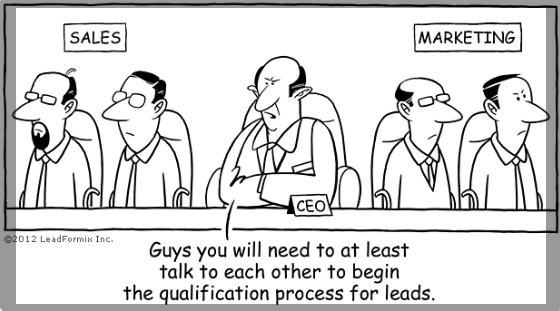— October 26, 2018
No secret that at best, marketing and sales departments coexist peacefully, without interfering in each other’s affairs. That’s not bad. But only if the business owner is satisfied with the financial results and has no ambition to scale.
However, if sales managers do not reach their targets, in most cases they start blaming it on marketing (e.g. lack of good leads, wrong messaging, bad website, no marketing automation, etc) and that’s when the peaceful life is over for the whole organization.
Marketers and salespeople are rarely on the same page. Why? Is it due to occupational discrimination or other factors? Let’s dive deep into the subject matter to see what hinders a happy marriage between sales and marketing teams, and how to create a synergy between them.
Today, most entrepreneurs divide corporate marketing and sales functions to avoid clashes. As a rule, departments work autonomously and independently of each other, and they only come into contact in crisis situations.
How does it look in practice?
Someone from the marketing department launches an advertising campaign in order to drive leads to sales, and wash their hands letting sales follow up and take care of the lead.
Many business owners want to see a clear distribution of responsibilities: marketing should bring leads, and sales should bring money. It all seems to be logical and correct. But! The main drawback of this division becomes obvious as soon as sales fail to deliver.
Marketers protect themselves by shouting out loud: “Coverage was great, requests were relevant. We did bring leads, so it’s your problem you can’t sell well!” And sales guys object that leads were rubbish! Half of the requests were irrelevant, leads were very cold, so they just wasted their time following up on those slim and crappy opportunities.
I’m sure each business owner is familiar with this vicious circle of blame shifting. Is there a way to stop it?
Why do marketers and salespeople have different DNAs?
First, they have different KPIs to measure as well as a different vision of solving business issues: sales managers live for today, and marketers act for the future.
Second, the outcome of the sales department can become clearly visible right away: if 30 calls have resulted in 15 transactions, the conversion rate is 50%. Yet, in order to evaluate the performance and results of the marketing department, time is needed, as it’s nearly impossible to see the results of a marketing campaign right upon completion.
Third, marketing and sales teams collect and use information in different ways. The first conduct research of the target audience, market, competitors and obtain objective data that is used to develop marketing strategies and test various hypotheses. The latter receive subjective information, but first-hand, that is, directly from the real client.
However, despite these differences, both departments pursue one common goal – to bring money to the business. And it’s logical that in order to achieve a better result, it’s necessary not only to reconcile these departments but to create a new unified business system in which both marketers and salespeople will act like a well-oiled machine.
How to put an end to the confrontation and achieve synergy
According to one Ernst&Young study, top 3 areas where marketing and sales departments add the most value to the company are:
- Driving innovation;
- Building and protecting the company’s brand;
- Creating value for money, i.e. exploiting in-depth tribal knowledge.
Also, companies that manage to achieve a symbiosis between sales and marketing enjoy sales increase by an average of 30%.
Some experts suggest that in order to put sales and marketing on the same page, a CRM system should be put in place. I’ve worked in companies where the whole interaction between sales and marketing was formalized through CRM and we still had the same problem of having sales and marketing live in different worlds. Yes, having CRM is a must, but CRM alone won’t solve the issue of miscommunication.

Combining marketing and sales into one system doesn’t mean that you have to lock your employees in one room and force sales to do advertising, and marketers to process customer requests. The essence of synergy is that each department understands and performs its functions, but in close conjunction with each other!
Marketers attract a solvent target audience, i.e. people who best fit avatars (an avatar is a detailed portrait of a client most attractive to the business). To do this, marketers need to know exactly who buys the product, based on sales experience. And in order to attract this particular audience, it’s important to understand what the real needs of existing customers are, as well as their objections, fears, and concerns. They can only get this information from sales and without it, they won’t be able to develop effective strategies to attract customers, select the right messages for marketing and communications campaigns, create relevant offers, strengthen branded content, and so on.
Next, marketers need to interact with and “warm up” this audience before letting sales managers approach them with their calls and emails. At this stage, marketers need to increase potential customers’ awareness of the brand and raise in them the feeling that they are in the right place. In addition, they have to work with their objections and cultivate the desire to make a purchase.
The main objective of marketing is to guide a person across the entire sales funnel (all the way from awareness and consideration to decision making and completing a purchase) and make their journey as pleasant and enjoyable as possible.
In its turn, sales have three main goals:
- consult warm leads and close deals;
- increase existing client’s lifetime value by selling additional services (upsale);
- collect customer insights for the marketing department.
That being said, if marketing has done a great job warming up the audience, handling objections with well-crafted content, and getting the company message through, then the sales process will be reduced to a minimum!
On the contrary, the output of any sales department will increase significantly due to the fact that managers won’t have to spend time on “cold” leads, will process more requests and inquiries, close more deals and bring the company more money. That is exactly what can be achieved by creating a synergy between these two teams.
But how to do it?
There’re four stages of creating a unified marketing and sales system for your business:
1. Create a logic for a profit generation process
You need to create a roadmap and describe all steps from launching a website to closing a deal. This will help you better visualize how exactly your company will make money from customers, eliminate bad and irrelevant requests, and pave a path for attracting the most relevant leads only!
2. Implement a CRM solution so that all data will be kept in one place
Ideally, you need to create an internal database that works both ways: the marketer looks at analytics, gets relevant information about customers, their preferences, pains, and fears, and uses it to enhance the strategy. The sales manager sees the path of the potential client, where they came from, what content they consumed, which will help reduce time to close a deal.
3. Define an MQL
CMO/Head of Marketing and CBDO/Sales Director should sit together and define what will be considered “a marketing qualified lead (MQL)”. For instance, at 8allocate, a custom software development company I currently work for, marketing and sales have agreed that an MQL is a person from an established mid-market and/or enterprise company who has sent us an RFP/RFQ along with a project specification or a pricing and resource availability request. If someone sends us a message through a website contact form asking about how to build a cutting-edge AI solution, we’ll most likely send them a link to a relevant Quora discussion or our own blog post addressing this topic, but we won’t pass it over to sales as an MQL.
This is a very important part of the process which is often omitted and underestimated by many sales and marketing teams. If this step is ignored, sales and marketing will never stop shifting blame and arguing with each other.
4. Create a performance monitoring and evaluation system
You need to set up KPIs that will be common for both sales and marketing and track them down in the context of the shared goal – revenue generation. These KPIs can be a percentage/ratio of conversion of inbound to outbound leads, cost of lead acquisition, return on marketing investment (ROMI), and so on.
Wrapping up, an effective collaboration between marketing and sales is something that every business should strive for. The result of such a merger is a more effective marketing strategy able to meet real-life user needs, eliminate their pain points, and provide valid arguments for their objections. And most importantly – revenue increase, as the sales department will manage to close more relevant and hot requests, without wasting time to work with objections and useless leads.
Business & Finance Articles on Business 2 Community
(46)






